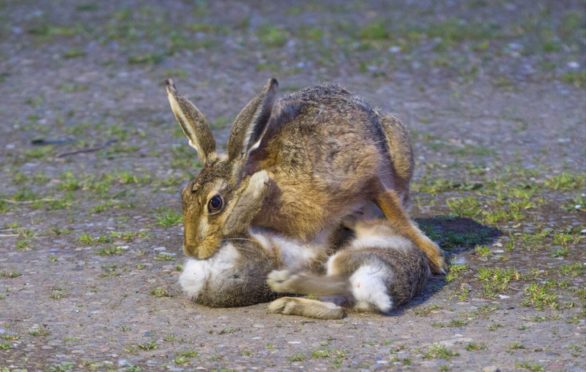Late one evening in May 2016 I went into the kitchen to make a cup of tea. While the kettle was boiling I did what I always do, I stared out of the window. And there, on the driveway was a dark blob. I tentatively switched on the outside light, but even then it took me a few seconds to realise what it was. A brown hare, bent over, with its back to me.
Hares had always been regular visitors to the garden – nibbling my wildflowers, boxing one another, hiding under cars or being dragged away by stoats. In fact I once found a hare asleep on the front doorstep and, unable to bring myself to disturb it, I deliberately stayed indoors for the whole morning. So where hares are concerned, I thought I’d seen everything.
But this hare was odd. It was clearly nibbling at something, but it couldn’t be eating because there was no vegetation. After a couple of minutes it adjusted its stance, revealing two smaller blobs below. Leverets! Two baby hares! And to my astonishment she was suckling them.
Seconds later, she bent down and started grooming them, and all I could see were four wee hind legs sticking out from under her. That lasted maybe a minute before she abruptly ran off without so much as a goodbye, leaving the tiny youngsters sprawled on the driveway looking shellshocked. Imagine camping in a tent and it being whisked away from you when you least expect, and you’re there. Ten seconds later, the leverets whizzed off into the gloom.
I was shellshocked too. As an avid nature nut I’d seen plenty of amazing things over the years, but this was off the scale. Was it unusual, though? Do hares normally suckle in the open like that? I had no idea, so I promptly hopped online to read up on hare ecology.
I knew that hares live their lives above ground, but I didn’t realise they’re born as fully-formed mini hares, with fur and open eyes. Rabbits are born naked, blind and helpless, so are born underground where it’s safe. But because hares are born above ground in shallow depressions in the grass, called forms, the weans need to be mobile from the get-go.
Although they gradually disperse from their birthplace, they stay in a form during the day, hiding from predators, and mum returns to the birthplace once a day to suckle them. Usually occurring around sunset, this is pretty much their only contact, and after three or four weeks the leverets are fully weaned.
At the time, I assumed it was a precious, once-in-a-lifetime wildlife encounter. The kind of thing you might spend your whole life actively searching for but still never see. But the following night, I peered out the window around the same time and yep, there they were again.
This time they were right outside the house and mum was facing right at me. Her amber eyes seemed to look in all directions at once, and her long ears were constantly searching like radar installations. I was mesmerised by the intimacy, and the chance to be closer than I’d ever been to these beautiful creatures. Incredibly, this happened for the next four nights.
After that I saw very few hares of any kind – just one in the whole of 2017 and none at all in 2018. But in June 2019, out of nowhere, a hare was again suckling outside the kitchen window. It did so for seven consecutive nights, initially with two leverets and then just one, after the other mysteriously disappeared.
And now, in May 2020, it has just happened again for an outrageous third time. Eight consecutive nights, right outside the house, and this time with THREE leverets! And as in previous years, the pleasure is in the details – the way the leverets somehow co-ordinate their emergence each evening. The way they groom one another before silently huddling together under the garden table. The way mum appears from out of nowhere, and so confidently sits in such an exposed location. And the way the feed seems to pump the youngsters up into wee frenzied fuzzballs of energy. They’re always so animated afterwards, with so much jumping and running. I won’t deny, it’s adorable – and so ridiculously obliging.
I mean, why there? Why right outside the window? Why not around the back of the house where I’d be none the wiser? Why not hidden behind the big old tree? Or in the field next door? I suppose I’ll never know, but I do wonder whether abandoning my “lawn” to its own devices has had something to do with it.
Whether or not it’s the same doe coming back year after year, I don’t know. Hares don’t live more than a few years, so if it is, my outrageous good fortune might only last as long as she does. But while I might not know what I’ve done to deserve it, I’m just so thankful and happy that they feel safe enough outside my home to visit.
Ben Dolphin is an outdoors enthusiast, countryside ranger and former president of Ramblers Scotland
